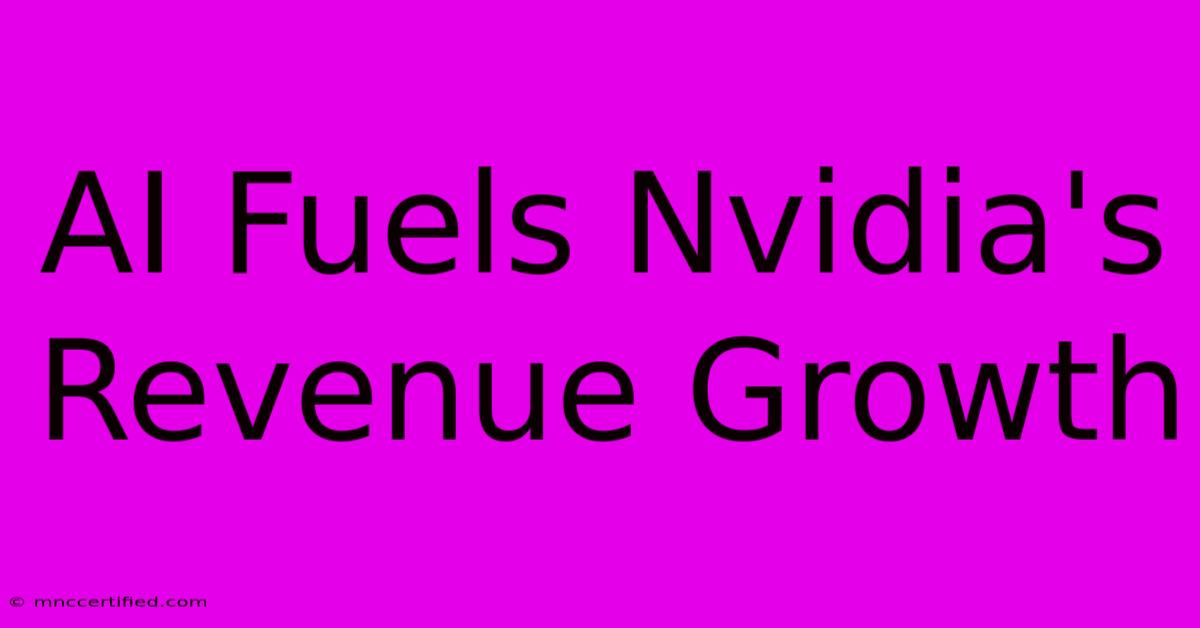AI Fuels Nvidia's Revenue Growth

Table of Contents
AI Fuels Nvidia's Revenue Growth: A Deep Dive into the Chipmaker's Success
Nvidia, once primarily known for its gaming GPUs, has experienced explosive revenue growth, largely fueled by the booming artificial intelligence (AI) market. This isn't just a temporary trend; AI is fundamentally reshaping Nvidia's business model and solidifying its position as a tech titan. This article will delve into the key factors driving this phenomenal growth, analyzing the company's strategic moves and the broader implications for the AI industry.
The AI Revolution: Nvidia's Unexpected Beneficiary
The rise of generative AI, machine learning, and large language models (LLMs) has created an unprecedented demand for high-performance computing (HPC) capabilities. Nvidia's GPUs, originally designed for gaming and graphics processing, have proven remarkably well-suited for the computationally intensive tasks required by AI. This isn't a coincidence; Nvidia's architecture, particularly its CUDA parallel computing platform, provides the necessary horsepower to train and run complex AI models.
Data Centers: The New Battlefield
Nvidia's success story isn't confined to gaming consoles. The company's data center business has become its primary revenue driver. Cloud computing giants like Amazon Web Services (AWS), Microsoft Azure, and Google Cloud Platform (GCP) are aggressively investing in AI infrastructure, and Nvidia's GPUs are at the heart of this expansion. The demand for powerful GPUs for training AI models, deploying AI applications, and powering AI-driven services is fueling this massive growth.
Beyond the Data Center: Expanding AI Horizons
Nvidia's influence extends far beyond data centers. The company's technology is crucial in various AI applications, including:
- Autonomous Vehicles: Nvidia's DRIVE platform provides the computational backbone for self-driving car development, powering perception systems, path planning, and decision-making algorithms.
- Robotics: The same powerful GPUs that excel in AI model training are equally valuable in powering real-time robotic control systems.
- Healthcare: AI is revolutionizing medical imaging and diagnostics, and Nvidia's technology plays a vital role in accelerating image processing and analysis.
Strategic Moves and Market Dominance
Nvidia's success isn't solely due to luck; it's the result of a series of smart strategic moves:
- Early Adoption of CUDA: Nvidia's early investment in CUDA, a parallel computing platform, gave it a significant head start in the AI market. This provided developers with a robust and widely adopted framework for AI development.
- Strategic Partnerships: Nvidia has forged strong partnerships with leading cloud providers and AI companies, solidifying its position in the ecosystem.
- Continuous Innovation: Nvidia consistently invests in research and development, pushing the boundaries of GPU technology and ensuring its continued relevance in the rapidly evolving AI landscape.
- Software Ecosystem: Nvidia's software ecosystem, including CUDA libraries and frameworks like TensorRT, significantly simplifies AI development and deployment, attracting a larger developer community.
The Future of Nvidia and AI
The future looks incredibly bright for Nvidia. As AI continues its rapid expansion into diverse sectors, the demand for high-performance computing will only intensify. Nvidia's strategic positioning, technological prowess, and strong ecosystem ensure it remains a key player, poised to benefit significantly from the ongoing AI revolution. However, competition is emerging, and Nvidia must continue innovating to maintain its market leadership.
Keywords:
Nvidia, AI, revenue growth, GPUs, data centers, artificial intelligence, machine learning, deep learning, generative AI, large language models (LLMs), cloud computing, autonomous vehicles, robotics, healthcare, CUDA, TensorRT, high-performance computing (HPC), market dominance, strategic partnerships, tech titan.
Off-Page SEO Strategies:
To further boost the article's ranking, consider the following off-page SEO strategies:
- Link building: Secure backlinks from reputable technology and business websites.
- Social media promotion: Share the article across relevant social media platforms.
- Guest blogging: Contribute articles to other relevant blogs in the tech industry.
By implementing both on-page and off-page SEO strategies, this article will have a much higher chance of ranking well on Google and attracting a large audience interested in Nvidia and the AI revolution.

Thank you for visiting our website wich cover about AI Fuels Nvidia's Revenue Growth. We hope the information provided has been useful to you. Feel free to contact us if you have any questions or need further assistance. See you next time and dont miss to bookmark.
Featured Posts
-
Powerful Ballad Brooks And Dunn Jelly Roll
Nov 21, 2024
-
Bourget Insurance Chippewa Falls
Nov 21, 2024
-
Ionic Bonds Gizmo Answer Key Pdf
Nov 21, 2024
-
Insurance Claims Lawyers Near Me
Nov 21, 2024
-
Christian Jerome Insurance Agent
Nov 21, 2024